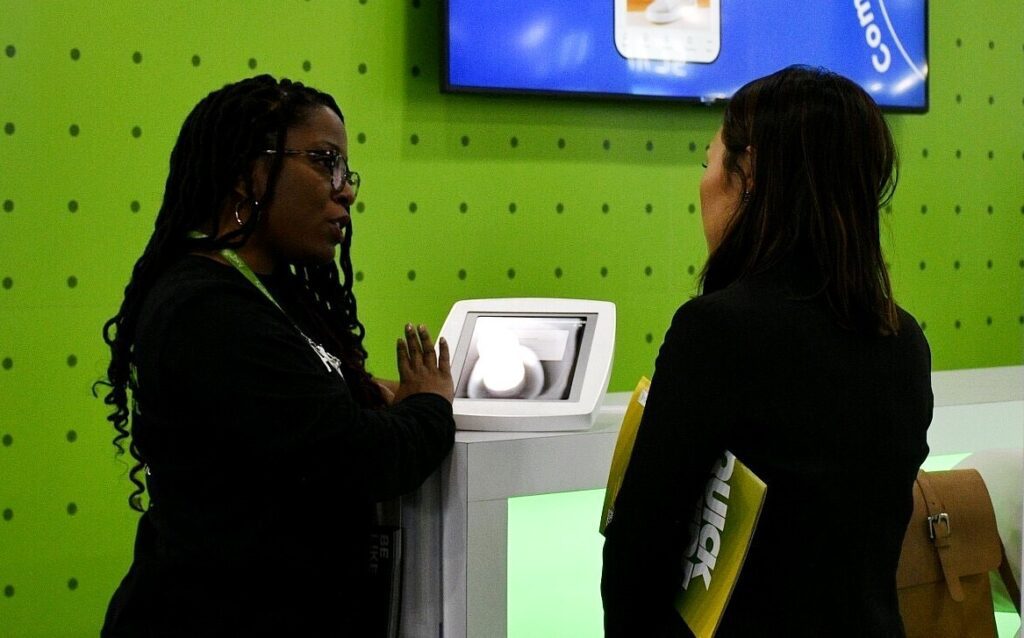What we overheard at NRF 2023
For the first time since 2019, NRF’s Big Show was held in person at the Jacob K. Javits Center in New York City. And people showed up.
Over three days, nearly 30,000 attendees navigated a labyrinth of booths featuring 1000-plus exhibitors (including two Axonify booths!). Keen crowds of local and international retailers, vendors, partners, buyers and sellers also took in 175 sessions where speakers touched on topics ranging from omnichannel strategies to consolidated solutions, associate enablement and sustainability—and how technology is at the center of it all.
That’s a lot of noise to sort through but we’ve distilled the themes into more manageable soundbites. Take a look at what we overheard at NRF 2023 and the biggest issues retailers and frontline organizations will be thinking about over the next 12 months.

Make it fast but it make last
A focus on real-time delivery, in both the literal sense, when it comes to product getting from stores to customers, and in reference to near-immediate access to problem-solving information, intersected many of the strategies businesses were trumpeting.
Despite the rise of BOPIS options, physical stores remain the preference for American shoppers. That means the omnichannel experience has to be consistent no matter where customers engage with your brand and making choices that bake agility into all touchpoints is key.
Marvin Ellison, Lowe’s CEO and Chairman, touted the brand’s commitment to hourly deliveries for over 30,000 SKUs that have been flagged for emergency needs. Because taking 24 hours to get a part needed for a burst pipe won’t cut it.
Equally important is the focus on associate enablement so staff are equipped with the proper training and tech to help out customers in moments of need. This can mean many things: using a workforce management tool to standardize operations across multiple locations so the experience is consistent from, say, one Kroger to the next; placing handheld devices in high-traffic areas so associates can pull up relevant product information in the flow of work; providing cross-skilling training opportunities so managers can maintain schedules that don’t overburden their teams.
The margin between a lifelong shopper and a one-time customer is razor-thin, as options are endless and consumers do their research. Getting them in, served and then out—with confidence and care—requires a commitment to employee development, which is unsurprisingly tied to business outcomes. It prioritizes immediate access with an eye toward long-term progress and profitability.
“Culture eats strategy for breakfast”
When speaking about how brands should approach sustainability, Jeffrey Hague, Levi’s Chief Sustainability Officer, quoted well-known management consultant and author Peter Drucker to highlight how important it is to align any external moves with the company culture first. This is especially true with environmental issues where accusations of inauthenticity and greenwashing are prevalent but can be broadly applied to any company implementing changes that purport to be genuine but feel superficial. DE&I strategies fall into this category and there’s research to prove that 80% of businesses are simply “going through the motions.”
Brands, then, have to take an active role and “find the sweet spot of how to make [their strategies] resonate with consumers,” said Hague. Since 80% of American shoppers consider sustainability when making at least some purchase decisions, it becomes crucial to make things like labeling and company initiatives easily understood by the public so they can show their support in various ways, including with their hard-earned dollars.
In the same way, when retailers are looking to influence others and get internal buy-in on their omnichannel strategies and investment in frontline tech, it’s important to consider how associates will be trained and enabled to use these tools, a topic touched on by speakers from Mejuri, VINCE and UNTUCKit during their NRF 2023 session. Does the solution align with how, when and where they actually work? Considering how digital habits and demographics intersect will also tell a large part of the story and vary from brand to brand and location to location and help to authentically connect strategic measures with internal culture.
Let’s hear it for the one-stop-shops
Having a unified tech stack is nothing new but when you consider how many apps the average person uses for work daily (the average is hovering at 13), it’s clear there’s a real need to consolidate and operate from a single source of truth on the way to peak performance and efficiency.
Retail is (finally) being reimagined with the employee experience in mind. As Steve Hunt, Chief Expert, Technology & Work at SAP SuccessFactors, pointed out, “tectonic shifts” in digitization and demographics mean that the work that’s expected from retail organizations is more complex than ever. And with the working age group (15-64) representing 64.8% of the population in Canada, companies need to figure out how to best leverage this cohort and use technology to transform what they’re able to learn and do.
Hunt made an important distinction: employees don’t want to be compliant or trained; they want to be successful. Giving them the right tools so they’re enabled to perform well in their roles, deliver on the required tasks and end their shifts with a real sense of accomplishment boosts their confidence, which impacts the bottom line. Retail moves fast and as we all know, the pandemic accelerated digital transformation—as Forbes put it, 2020 became 2025—so it only makes sense that the frontline is given what they need to keep up with expectations and then, ideally, exceed them.
How exactly the retail industry will continue to morph and change over the next year will be interesting to observe for those who are committed to its success and evolution. No matter the unexpected turns it may take, at the center of it all will be two constants: the associate experience and the technology they’re using to do their jobs, better.